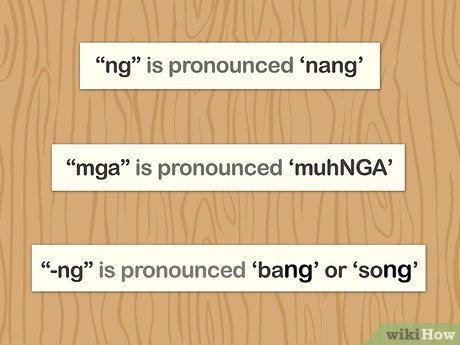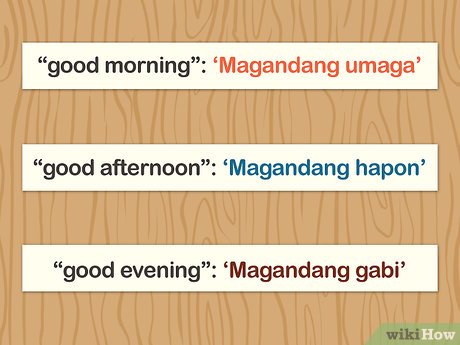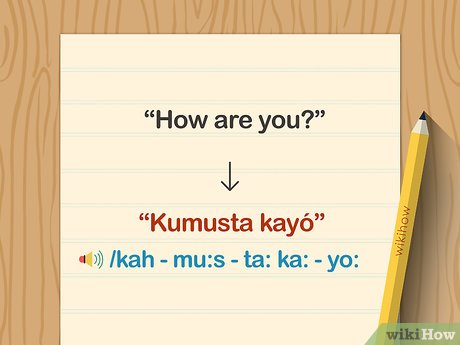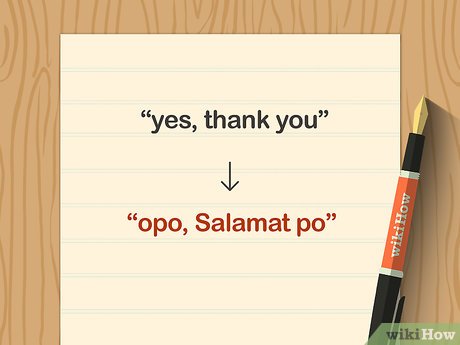How to Greet People from the Philippines
Method 1 of 2:
Learning the Basics
-
 Remember that almost everything you read in Tagalog or Filipino is phonetic. This means that words can be sounded out. Try to sound it out the way you see it and you will most likely be close to the correct pronunciation.
Remember that almost everything you read in Tagalog or Filipino is phonetic. This means that words can be sounded out. Try to sound it out the way you see it and you will most likely be close to the correct pronunciation.- Vowels are harder than in American English, but softer than in a British accent. Also, all the vowels are unrounded, except for /o/.[2]
- There are exceptions though: ng is pronounced 'nang' and mga is pronounced 'muhNGA'. The '-ng', which is a single letter, is pronounced as in 'bang' or 'song'.
-
 Learn a little of the language before you visit. You can learn Filipino or Tagalog by reading books, viewing television, listening to music, or watching videos. Just like other languages, it is still best if you practice by conversing with someone who knows the language.
Learn a little of the language before you visit. You can learn Filipino or Tagalog by reading books, viewing television, listening to music, or watching videos. Just like other languages, it is still best if you practice by conversing with someone who knows the language.- If you have a limited amount of time, focus your studying on common greetings that you are likely to use. Don't try to learn all the grammar and structure of the language if you are visiting in the near future.
-
 Learn how to say the equivalent of good morning, good afternoon, and good evening. There is no literal translation for these phrases. Instead, Filipinos greet each other by saying "beautiful" before day, afternoon, or evening.[3][4]
Learn how to say the equivalent of good morning, good afternoon, and good evening. There is no literal translation for these phrases. Instead, Filipinos greet each other by saying "beautiful" before day, afternoon, or evening.[3][4]- To say good morning, say "Magandang umaga" (ma-gan-dang u-ma-ga), which literally means beautiful morning.
- To say good afternoon, say "Magandang hapon" (ma-gan-dang ha-pon), which literally means beautiful afternoon.
- To say good evening, say "Magandang gabi" (ma-gan-dang ga-bi), which literally means beautiful evening.
-
 Try English if all else fails. Filipinos are generally accustomed to English in fact, 96.3% of Philippine population consider English as a second language and Filipinos can speak English fluently also, so you can simply say "Hi," "Hello," 'Good Morning,' etc. The person you are greeting will probably understand your basic greeting in English.[5]
Try English if all else fails. Filipinos are generally accustomed to English in fact, 96.3% of Philippine population consider English as a second language and Filipinos can speak English fluently also, so you can simply say "Hi," "Hello," 'Good Morning,' etc. The person you are greeting will probably understand your basic greeting in English.[5]- If you get stuck and don't know what to say, just speak in English. It is better to say something in English than nothing at all.
- However, if you want to impress those you interact with, then go ahead and study the language so you are prepared!
-
 Greet a group of friends. If you are trying to impress a new group of friends, say "Kumusta kayó" when you approach them. This is the plural form of "How are you?"[6]
Greet a group of friends. If you are trying to impress a new group of friends, say "Kumusta kayó" when you approach them. This is the plural form of "How are you?"[6]- It is pronounced /kah - mu:s - ta: ka: - yo:/.
-
 Speak differently to elders. If you are talking to someone who is older or of higher social rank than you, always add po to your sentences. Po is usually added at the end of a sentence, for example "Salamat po" means "thank you."
Speak differently to elders. If you are talking to someone who is older or of higher social rank than you, always add po to your sentences. Po is usually added at the end of a sentence, for example "Salamat po" means "thank you."- Also, use opo to say "yes." This is basically the equivalent of saying "yes, ma'am" or "yes sir."
Method 2 of 2:
Interacting with New People
-
 Shake people's hands. In Filipino culture it is generally best to shake hands with someone that you are meeting for the first time. This is usually a soft hand shake, not an overly firm one.[7]
Shake people's hands. In Filipino culture it is generally best to shake hands with someone that you are meeting for the first time. This is usually a soft hand shake, not an overly firm one.[7]- Greeting someone you just met with a kiss on the cheek or a hug is not usually done. This is most often reserved for once you have developed a relationship.[8]
- If you are in a Muslim area of the Philippines, then the rules for touching, especially between men and women, may be different. Shaking hands may still be appropriate but men may need to initiate. Notice what others are doing around you and follow their lead.[9]
-
 Consider using a "mano" greeting with elders. Filipino elders are often greeted by taking their right hand and bringing it up to touch your forehead. This is called "mano." This is especially important to do with ones own family members and with those that are extremely elderly.[10]
Consider using a "mano" greeting with elders. Filipino elders are often greeted by taking their right hand and bringing it up to touch your forehead. This is called "mano." This is especially important to do with ones own family members and with those that are extremely elderly.[10]- If an elderly person holds out their hand in front of their body with the palm facing down, this may be a sign that they are expecting a "mano" greeting.
- This greeting is about you respecting your elders but it is also about the elder blessing you when they touch your forehead.[11]
-
 Keep the conversation light and friendly. As with many people all over the world, Filipinos don't necessarily want to talk about politics or serious topics with strangers. Instead, focus your conversations on the joys of life: family, food, and fun. This will make getting to know this new person more enjoyable.
Keep the conversation light and friendly. As with many people all over the world, Filipinos don't necessarily want to talk about politics or serious topics with strangers. Instead, focus your conversations on the joys of life: family, food, and fun. This will make getting to know this new person more enjoyable.- In general, Filipinos love to laugh. They do it genuinely but they also laugh to move away from uncomfortable topics or to break tension. Be aware of this and be willing to change the subject if you notice this cue.[12]
4 ★ | 1 Vote
You should read it
- How to learn English for free with Vndoc, from basic to advanced
- 12 Facebook Pages useful for English learners
- Good English game, learning while playing
- How to Use a Period in Writing
- 3 best free dictionaries to learn English on Android and iOS, with download link
- Top 23 top English learning apps on Android and iOS
- Top 5 English pronunciation instructions on PC
- 4 free English learning apps on smartphones
May be interested
- The field of switchboard operators suffered the sweep of the 'AI tsunami'
 a year ago, bernie was an employee at a service call center in the philippines, secretly using chatgpt to help reduce the pressure on the operator. however, now this ai is threatening his job.
a year ago, bernie was an employee at a service call center in the philippines, secretly using chatgpt to help reduce the pressure on the operator. however, now this ai is threatening his job. - Found 400-year-old Chinese ceramic shipment in Mexico
 a series of hundreds of years old ceramic artifacts originating from china have been found in mexico with stories of stirring and exciting international archaeological circles.
a series of hundreds of years old ceramic artifacts originating from china have been found in mexico with stories of stirring and exciting international archaeological circles. - Sitting and playing games under a tree in stormy weather, 2 Filipino youths were struck by lightning
 on june 23, two cousins jimboy and jericho laura, 18 in elena, camarines norte, philippines were struck by lightning while playing the game mobile legends on smartphones at the base of the tree when it rained.
on june 23, two cousins jimboy and jericho laura, 18 in elena, camarines norte, philippines were struck by lightning while playing the game mobile legends on smartphones at the base of the tree when it rained. - Apple brought Vietnam to the list of iPhone 5S sales from November 15
 along with ipad mini retina screens, apple today also announced that vietnam and the philippines are the two countries preparing to sell iphones 5s and 5c.
along with ipad mini retina screens, apple today also announced that vietnam and the philippines are the two countries preparing to sell iphones 5s and 5c. - Google's new experience, Triangle, allows blocking applications that use mobile data as needed
 recently, google has begun testing a new tool to help users manage mobile data better with smartphones. the new android app called triangle, is currently being tested in the philippines.
recently, google has begun testing a new tool to help users manage mobile data better with smartphones. the new android app called triangle, is currently being tested in the philippines. - Why are smart people usually few?
 have you ever noticed family and friends of really smart people and wondered how many people they chose for their friends circle? smart people often have fewer friends than normal people and below are the reasons.
have you ever noticed family and friends of really smart people and wondered how many people they chose for their friends circle? smart people often have fewer friends than normal people and below are the reasons. - Samsung in turn swirled Apple's iPhone
 shortly after apple introduced the iphone 6 and iphone 6 plus duo, samsung philippines' official twitter page posted a tweet tweeted that apple increased the screen size for iphone 6.
shortly after apple introduced the iphone 6 and iphone 6 plus duo, samsung philippines' official twitter page posted a tweet tweeted that apple increased the screen size for iphone 6. - Map showing which celebrities were born in their country
 a famous map designer from mapbox has designed a new interactive map website that shows all the famous people from around the world and where they were born.
a famous map designer from mapbox has designed a new interactive map website that shows all the famous people from around the world and where they were born. - Impressive numbers when the Earth shrinks with 100 inhabitants
 did you know, how many colored people on earth on our planet, how many left-handed people, how many homeless people, how many people are overweight ...?
did you know, how many colored people on earth on our planet, how many left-handed people, how many homeless people, how many people are overweight ...? - Only extremely intelligent people often encounter these problems
 don't think smart people are immune to all the problems in the world, the things they encounter are sometimes not complicated at all as we often think.
don't think smart people are immune to all the problems in the world, the things they encounter are sometimes not complicated at all as we often think.



















 How to Lose Your Voice
How to Lose Your Voice How to Write an Argumentative Research Paper
How to Write an Argumentative Research Paper How to Improve Math Skills
How to Improve Math Skills How to Do a Case Study
How to Do a Case Study How to Use Google Translate
How to Use Google Translate How to Write a Conclusion
How to Write a Conclusion